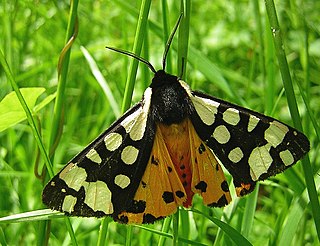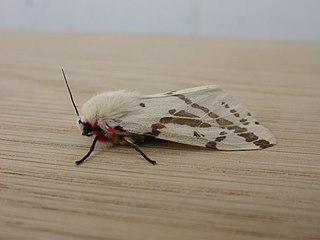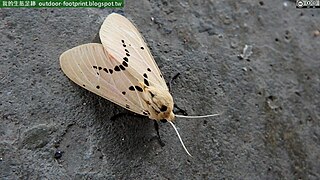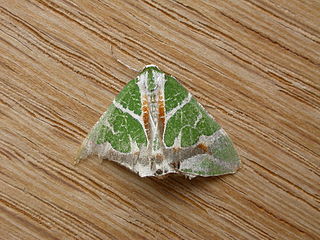
The Arctiinae are a large and diverse subfamily of moths, with around 11,000 species found all over the world, including 6,000 neotropical species. This group includes the groups commonly known as tiger moths, which usually have bright colours, footmen, which are usually much drabber, lichen moths, and wasp moths. Many species have "hairy" caterpillars that are popularly known as woolly bears or woolly worms. The scientific name of this subfamily refers to this hairiness. Some species within the Arctiinae have the word tussock in their common name due to people misidentifying them as members of the Lymantriinae based on the characteristics of the larvae.

The buff ermine is a moth of the family Erebidae. It is sometimes placed in the genus Spilosoma. The species was first described by Johann Siegfried Hufnagel in 1766. It is found throughout the temperate belt of the Palearctic region south to northern Turkey, Georgia, Kazakhstan, southern Siberia, eastern Mongolia, Amur Region, China, Korea and Japan.

Nyctemera is a genus of tiger moths in the family Erebidae first described by Jacob Hübner in 1820. The genus includes the species Nyctemera annulata and Nyctemera amica, which are closely related and are able to interbreed.

The Arctiini are a tribe of tiger moths in the family Erebidae.

The Arctiina are a subtribe of moths in the family Erebidae.
Ardices is a genus of tiger moths in the family Erebidae. The genus was erected by Francis Walker in 1855 and the moths are found in Australia.

Holoarctia is a genus of moths in the family Erebidae.

Palearctia is a genus of tiger moths in the family Erebidae.

Ardices curvata, the crimson tiger moth, is a moth of the family Erebidae. It was first described by Edward Donovan in 1805 and it is found in Australia. The species was formerly included in Spilosoma, but later generic status of Ardices was proved by Vladimir Viktorovitch Dubatolov (2005).

Ardices canescens, the dark-spotted tiger moth or light ermine moth, is a moth in the family Erebidae that is found across most of Australia. It originally was included in the genus Spilosoma, but later the generic status of Ardices was proven.

Spilarctia is a genus of moths in the family Erebidae. The genus was erected by Arthur Gardiner Butler in 1875.

Spilosoma is a genus of moths in the family Erebidae originally described by John Curtis in 1825. A very heterogeneous group, it is in need of review by the scientific community, as certain species probably need reclassification into their own genera.

Chlorodes is a monotypic moth genus in the family Geometridae erected by Achille Guenée in 1857. Its only species, Chlorodes boisduvalaria, or Boisduval's emerald, first described by Élie Jean François Le Guillou in 1841, is known from Australia, including Tasmania.

Gastrinodes is a genus of moths in the family Geometridae erected by William Warren in 1898. Its species occur in Australia. Its type species is G. bitaeniaria, originally described as Geometra bitaeniaria.

Chlenias banksiaria is a moth of the family Geometridae first described by Élie Jean François Le Guillou in 1841. It is found in the Australian Capital Territory, New South Wales, Victoria and Tasmania.

The Nyctemerina are a subtribe of woolly bear moths in the family Erebidae.
Streltzovia is a genus of moths in the subfamily Arctiinae from East Asia. By general appearance, it is very similar to Spilosoma species, but male genitalia are different. The genus consists of only one species, Streltzovia caeria, which is found China.
Radiarctia is a genus of moths in the family Erebidae from Afrotropics.

Lemyra stigmata is a moth of the family Erebidae. It was described by Frederic Moore in 1865. It is found in China, Pakistan, India, Nepal, Bhutan, Myanmar, Thailand and Vietnam.

Spilosoma rubidus is a moth in the family Erebidae. It was described by John Henry Leech in 1890. It is found in China and Taiwan.





















